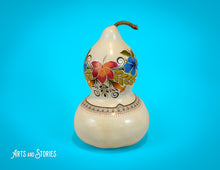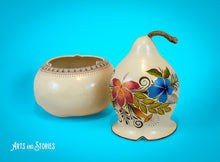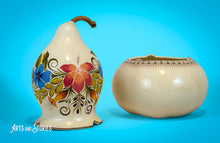
This work is done by artisans from Temalacatzingo belongs to the municipality of Olinalá, Guerrero, Mexico, located in the mountain region large part of the population speak the Nahuatl language (around 3600 inhabitants)
The word "Guaje" comes from Nahuatl "Huaje".
It belongs to the legume family, its drying process takes two months, once the guaje is dry, it goes away and is polished, until it is ready to be painted.
The guajes, are decorated in a traditional and indigenous way, with vegetal paintings that the artisans produce (chia oil, tecoxtle, calcite, quartz, limestone and natural pigments).
Preserving prehispanic art, with deer tails and guajolote feathers they make their brushes and maque technique decorate these objects, giving shape to mythical and traditional figures and colors of Mexico.
The word "Guaje" comes from Nahuatl "Huaje".
It belongs to the legume family, its drying process takes two months, once the guaje is dry, it goes away and is polished, until it is ready to be painted.
The guajes, are decorated in a traditional and indigenous way, with vegetal paintings that the artisans produce (chia oil, tecoxtle, calcite, quartz, limestone and natural pigments).
Preserving prehispanic art, with deer tails and guajolote feathers they make their brushes and maque technique decorate these objects, giving shape to mythical and traditional figures and colors of Mexico.







